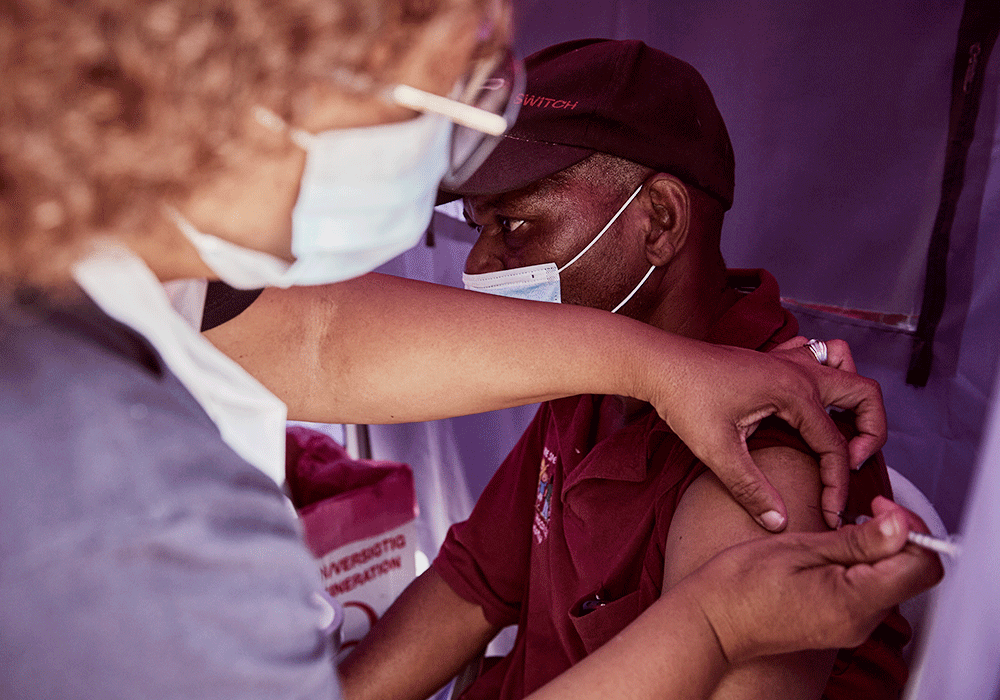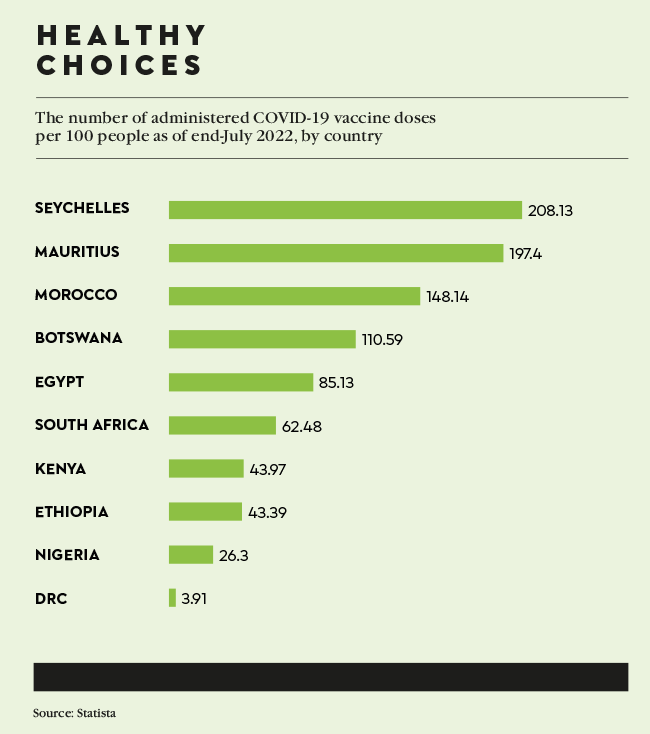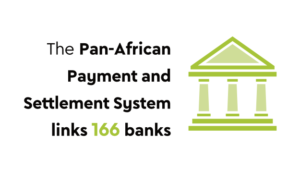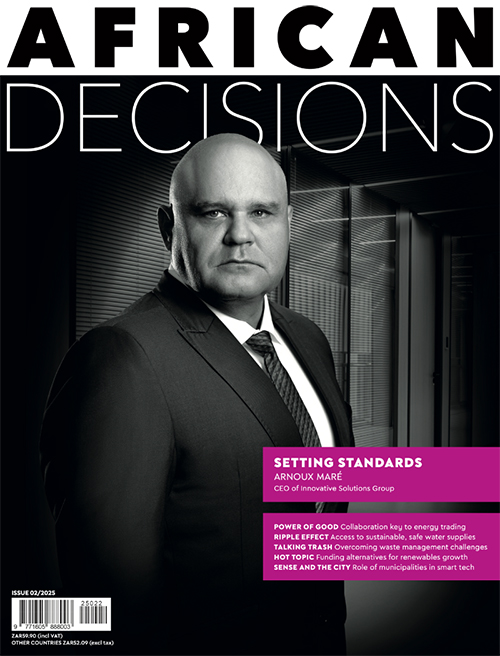As of June this year, only 17% of Africa’s population had been fully vaccinated – more than 50% short of the Africa Centres for Disease Control’s (Africa CDC) target of 70% vaccination by the end of 2022.
While the logistics of procuring and providing access to vaccines is one challenge facing African governments, a tandem responsibility is educating their citizens about the benefits of the vaccines, fighting fake news, providing information about vaccination facility access and, ultimately, convincing individuals and communities to get inoculated.
Perhaps chief among these is combating misinformation leading to vaccine hesitancy. It’s tricky to form an accurate picture of vaccine hesitancy in Africa. According to the World Bank, a 2020 Africa CDC survey of 15 countries found that while 79% of respondents would agree to a COVID-19 vaccine, vaccine hesitancy was as high as 38% in some nations; in a 2021 five-country survey, six out of 10 citizens in Benin, Liberia, Niger, Senegal and Togo were hesitant to get vaccinated.
Social media is, undoubtedly, the ‘main vein’ distributing misinformation about vaccines, from hyperbolic reports of side effects on the mild end, to outlandish conspiracy theories about genocide or mind control on the extreme end. In another study reported by the World Bank, in South Africa this time, approximately a third of those who would refuse the vaccine trusted social media as a primary source of information.
In response, governments – in co-ordination with health organisations, NGOs and the private sector – have had to develop strategic, well-co-ordinated multi-platform vaccination campaigns to capitalise on this trust, and address the scourge of misinformation at the same time. Indeed, Africa’s COVID-19 vaccination uptake rose by 15% in January and February this year thanks to ‘mass-vaccination drives’ – in other words, co-ordinated campaigns. According to the WHO, ‘a mass-vaccination campaign in Ethiopia, for instance, pushed up the number of doses administered by 136% between 23 January and 6 March 2022. In Kenya, a two-week mass-vaccination drive in early February saw an average of 200 000 people vaccinated daily, compared with 70 000 per day before the campaign. Tanzania, while not yet carrying out mass vaccinations, witnessed an increase of 152% in vaccine uptake between January and February’.
While internet access is relatively low in sub-Saharan Africa – around 30% – mobile-phone use is estimated at 83%. Of course, more developed countries have higher internet speeds, and by extension, social media access. ‘Our 2021 study of 1 000 participants based in Johannesburg and Cape Town indicated that more than 800 participants accessed COVID-19 information via social media,’ says Elizabeth Lubinga, a professor from the department of strategic communications at the University of Johannesburg, who has a special interest in health communications. ‘Online vaccination campaigns should play a significant role in addressing vaccine hesitancy among target audiences that have access to online media, primarily because e-word-of-mouth through social media platforms has been notorious, in addition to face-to-face word-of-mouth, for spreading misinformation about COVID-19 vaccines and the negative side effects thereof.’ Statistics indicate that in 2021, 36.45 million South Africans accessed the internet through mobile devices, a number expected to rise to 38.23 million in 2022 – which means carefully targeted messages can reach well more than half the population via social or online platforms.
Social media is uniquely placed to ‘meet people where they’re at’, helping governments and healthcare providers build trust with their target audience through initiating discussions and answering questions, and to create online communities where those with common interests and concerns can find information, start their own conversations and generate their own content.
Needless to say, targeted health communications is a specialised field that requires in-depth knowledge of audience demographics, the channels that are most likely to reach them, and the kind of messaging that will hit home. Vaccination messages targeted at over-50s would – and should – look completely different to messages targeting the youth. Take, for example, the South African government’s AMA50+ campaign versus its #KeReady campaign; the former aimed to convince over-50s to get the COVID-19 vaccine, while the latter was directed at the 12 to 34 age group. ‘Each campaign had a specific target audience,’ says Nombulelo Leburu, Department of Health (DoH) director of external communications. ‘Data highlighted that young people were not coming forward to vaccinate, and there was a need to mobilise them into action. This led to the creation of #KeReady. To date, we have had more than half a million young people who have come forward to vaccinate, who, had it not been for the #KeReady campaign, would not have been motivated to vaccinate.’
Launched on 18 February 2022, the #KeReadySA message centred on being ‘ready’ for the future with a mask, hand-sanitiser … and vaccination. The campaign was accompanied by the #KeReady2Flex Challenge, an incentive for youth to ‘flex’ their creativity by using the vaccination theme to draw, dance, act or sing, and submit their work via WhatsApp and other social media channels. Participants could win their share of ZAR100 000 worth of prizes each week. The #KeReady campaign has reached almost 6 million via social media, with nearly 1 million WhatsApp inbox messages since the launch, and the #KeReady2Flex Challenge has reached 4.6 million, with 241 000 Instagram profile impressions and 408 000 Twitter impressions.
In June, South Africa’s vaccinated adult population passed the halfway mark; but renewed momentum is needed to reach 70% by the close of 2022 – especially among young adults (just 37% of 18- to 30-year-olds have received a vaccination shot). ‘We have reached a critical stage in the COVID-19 vaccination roll-out,’ says Toby Fricker, Unicef South Africa chief of communication. ‘The challenge now is to further increase coverage by encouraging and actively engaging young people in the COVID-19 vaccination roll-out.’
Much of the South African government’s vaccine campaign success is thanks to the support of Project Last Mile (PLM), a cross-sector partnership that leverages the Coca-Cola Company’s reach and know-how to support public health departments in getting medicines to the public.
‘As the vaccine roll-out progressed, a need emerged to identify more innovative, non-traditional communication approaches to motivate vaccine uptake, especially among the youth,’ says Camilla Osborne, risk communications technical lead for PLM.
‘With that in mind, PLM shifted its focus to testing alternative approaches, focusing on incentivising vaccine uptake and engaging youth in content creation through micro-nano influencers. One approach was to partner with local TikTok content creators through a media agency to create their own content to promote vaccination in an easy-to-understand, engaging way. The campaign reached a total of 12 million engagements over three weeks on TikTok and demonstrated a successful, alternative way of engaging youth around vaccines. It also helped to bring the topic of COVID-19 vaccination back into the mainstream conversation at a time of increasing complacency.’
PLM also supported the DoH on the Safer Holidays campaign that ran over Christmas and the Easter break. ‘During both periods, digital assets such as banners and videos were played on various websites targeted to specific audience groups. The digital assets during the festive season campaign clicked through to the DoH microsite and the Easter campaign clicked through to the FindMyJab website.’ FindMyJab.co.za – created by the DoH in partnership with USAID and Right to Care – uses the visitor’s location to help them find their nearest vaccination site.
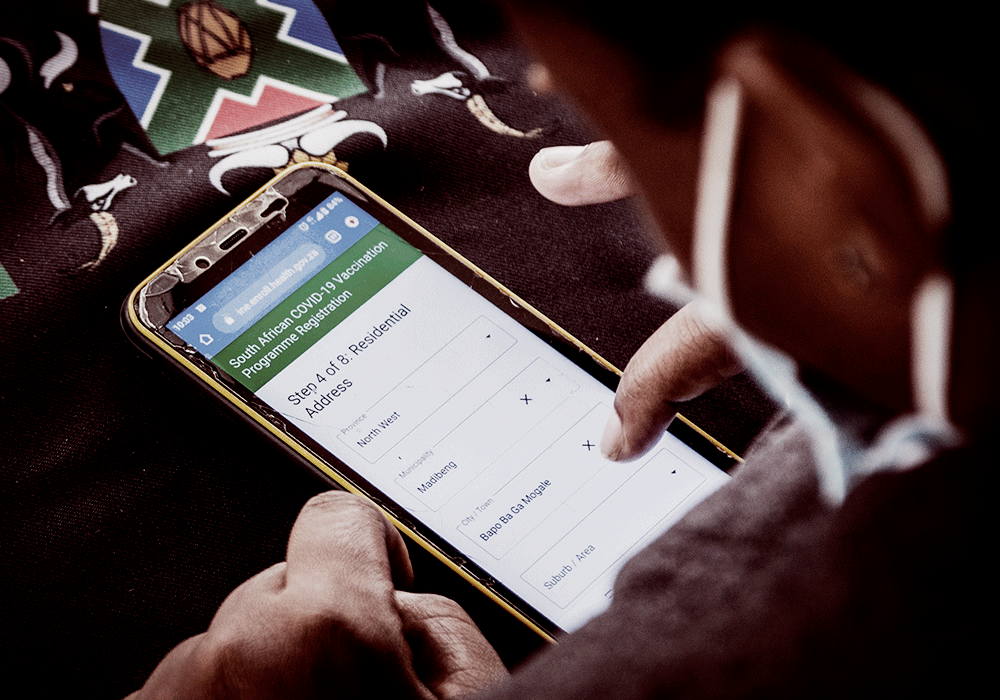
‘The DoH microsite recorded 37 000 page views and the time people spent on the site increased from 50 seconds to almost two minutes during the campaign period. The FindMyJab site recorded 38 000 visits during the period, compared to an average of only 1 700 visits over the previous months,’ says Osborne.
Surveys show vaccine hesitancy may be gradually decreasing in South Africa as communication efforts continue, she adds. Between rounds three and five of the UJ-HSRC COVID-19 Democracy Survey, the percentage of people hesitant about the vaccine dropped from 33% to 28%, and then to 25% in the latest round. Additionally, according to the Johns Hopkins C19 Behaviour Dashboard, the percentage of unvaccinated people who tried to get vaccinated rose by 7% from September 2021 to February 2022.
Despite the clear success of well-targeted online vaccination campaigns, lessons learnt will need to be distilled and deployed in future campaigns to keep the momentum going, and to connect to harder-to-reach people as well as the vaccine hesitant, if Africa is to catch up to the developed world’s vaccination rates.

